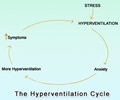Scientists are seeking a possible link between solar energy surges and the occurrence of strokes in human beings.
Neurologists who traced about 6,800 strokes and related cerebral attacks in a region of Slovakia are studying whether solar cycles, solar wind and geomagnetic storms on Earth may be somehow connected to human health.Michal Kovac and a colleague at a neurology clinic in the city of Nove Zamky, southwest Slovakia, found that the number of strokes among local residents rose significantly every 10.5 years and 7.04 years - time periods that correspond to solar-flare cycles that impact on Earth.
Their report, published recently in the Bratislava Medical Journal, provided fresh research for the field of chronobiology - the study of biological cycles such as the circadian rhythms that affect human sleep.
Kovac used a time graph to trace three kinds of cerebral attacks over a 16-year period between January 1989 and December 2004 among the 180,000 people living in the Nove Zamky area. He wanted to know whether the population's stroke rates rose and ebbed according to a regular pattern.
The study found that the solar flare cycles of 10.5 years, the average period between peak sunspot activity and quiet, as well as the seven-year cycles for geomagnetic activity "were significant in all three clinical diagnoses".
Energy generated by solar flares travels through space with solar wind and causes geomagnetic storms when it reaches Earth, according to the American Geophysical Union.
Advertisement
A group of scientists in 1992 discovered a seven-year cycle for intestinal worm attacks in humans, while other scientists in 1993 found tapeworms occurring in seven-year and 12-year rhythms in swine as well as sheep.
Advertisement
Kovac wrote that his and other theories linking human health and time cycles in nature are "so far generally ignored due to insufficient understanding of inferential statistics and chronobiology among doctors".
However, "It is possible that such variables will in the future be monitored from the point of view of prevention of diseases", he added.
In reviewing Kovac's work, scientists with the Halberg Chronobiology Centre at the University of Minnesota in the US said it showed that "magneto-periodic mechanisms remain to be investigated."
They also called it "a plea for worldwide access to morbidity, mortality and natality data that constitute a largely unexploited treasure" for the chronobiology field.
--Edited IANS











